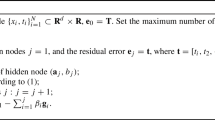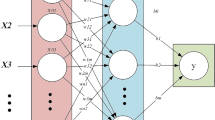Abstract
On account of transportation management, a predictive model of the traffic flow is built up that would precisely predict the traffic flow, reduce longer travel delays. In prediction model of traffic flow based on traditional neural network, the parameters of prediction model need to be tuned through iterative processing, and these methods easily get stuck in local minimum. The paper presents a novel prediction model based on back propagation bidirectional extreme learning machine (BP-BELM). Parameters of BP-BELM are not tuned by experience. Compared with back propagation neural network, radial basis function, support vector machine and other improved incremental ELM, the combined simulations and comparisons demonstrate that BP-BELM is used in predicting the traffic flow for its suitability and effectivity.









Similar content being viewed by others
References
Lv Y, Duan Y, Wang W, Li Z, Wang F (2015) Traffic flow prediction with big data: a deep learning approach. IEEE Trans Intell Transp Syst 2(16):865–873
Huang W, Song G, Hong H, Xie K (2014) Deep architecture for traffic flow prediction: deep belief networks with multitask learning. IEEE Trans Intell Transp Syst 5(15):2191–2201
Kumar SV (2017) Traffic flow prediction using kalman filtering technique. Procedia Eng 187:582–587
Koesdwiady A, Soua R, Karray F (2016) Improving traffic flow prediction with weather information in connected cars: a deep learning approach. IEEE Trans Veh Technol 12(65):9508–9517
Xu Y, Kong Q, Klette R, Liu Y (2014) Accurate and interpretable bayesian MARS for traffic flow prediction. IEEE Trans Intell Transp Syst 6(15):2457–2469
Oh S, Kim Y, Hong J (2015) Urban traffic flow prediction system using a multifactor pattern recognition model. IEEE Trans Intell Transp Syst 5(16):2744–2755
Moretti F, Pizzuti S, Panzieri S, Annunziato M (2015) Urban traffic flow forecasting through statistical and neural network bagging ensemble hybrid modeling. Neurocomputing 167:3–7
Chan K, Dillon T, Singh J, Chang E (2012) Neural-network-based models for short-term traffic flow forecasting using a hybrid exponential smoothing and levenberg-marquardt algorithm. IEEE Trans Intell Transp Syst 2(13):644–654
Chan K, Dillon T (2013) On-road sensor configuration design for traffic flow prediction using fuzzy neural networks and taguchi method. IEEE Trans Instrum Meas 1(62):50–59
Jeong Y, Byon Y, Castro-Neto M, Easa S (2013) Supervised weighting-online learning algorithm for short-term traffic flow prediction. IEEE Trans Intell Transp Syst 4(14):1700–1707
Polson N, Sokolov V (2017) Deep learning for short-term traffic flow prediction. Transp Res Part C Emerg Technol 79:1–17
Guo D, Zhang Y, Xiao Z, Mao M, Liu J (2015) Common nature of learning between bp-type and hopfiled-type neural networks. Neurocomputing 167:439–448
Qi XX, Yuan ZH, Han XW (2015) Diagnosis of misalignment faults by tacholess order tracking analysis and RBF networks. Neurocomputing 169:439–448
Ekici S, Yildirim S, Poyraz M (2009) A transmission line fault locator based on Elman recurrent networks. Appl Soft Comput 9(1):341–347
Huang GB, Chen L, Siew CK (2006) Universal approximation using incremental constructive feedforward networks with random hidden nodes. IEEE Trans Neural Netw 17(4):879–892
Huang GB, Chen L (2007) Convex incremental extreme learning machine. Neurocomputing 70(16–18):3056–3062
Huang GB, Chen L (2008) Enhanced random search based incremental extreme learning machine. Neurocomputing 71(16–18):3460–3468
Miche Y, Sorjamaa A, Bas P, Jutten C, Lendasse A (2010) OP-ELM: optimally pruned extreme learning machine. IEEE Trans Neural Netw 21(1):158–162
Feng G, Huang GB, Lin Q, Gay R (2009) Error minimized extreme learning machine with growth of hidden nodes and incremental learning. IEEE Trans Neural Netw 20(8):1352–1357
Lan Y, Soh YC, Huang GB (2010) Two-stage extreme learning machine for regression. Neurocomputing 73(16):3028–3038
Yang YM, Wang Y, Yuan X (2012) Bidirectional extreme learning machine for regression problem and its learning effectiveness. IEEE Trans Neural Netw Learn Syst 23(9):1498–1505
Horn RA, Johnson CR (2012) Matrix analysis. Cambridge University Press, Cambridge
He WW, Wang ZZ, Jiang H (2008) Model optimizing and feature selecting for support vector regression in time series forecasting. Neurocomputing 72(1):600–611
Wu YK, Tan HC, Qin LQ, Ran B, Jiang ZX (2018) A hybrid deep learning based traffic flow prediction method and its understanding. Transp Res Part C 90:166–180
Zhang HJ, Li JX, Ji YZ, Yue H (2017) Understanding subtitles by character-level sequence-to-sequence learning. IEEE Trans Industr Inf 13(2):616–624
Author information
Authors and Affiliations
Corresponding author
Ethics declarations
Conflict of interest
The authors (Weidong Zou, Yuanqing Xia) of paper (Title: Back propagation bidirectional extreme learning machine for traffic flow time series prediction, NCAA-D-17-01893) declare that there is no conflict of interests.
Rights and permissions
About this article
Cite this article
Zou, W., Xia, Y. Back propagation bidirectional extreme learning machine for traffic flow time series prediction. Neural Comput & Applic 31, 7401–7414 (2019). https://doi.org/10.1007/s00521-018-3578-y
Received:
Accepted:
Published:
Issue Date:
DOI: https://doi.org/10.1007/s00521-018-3578-y




